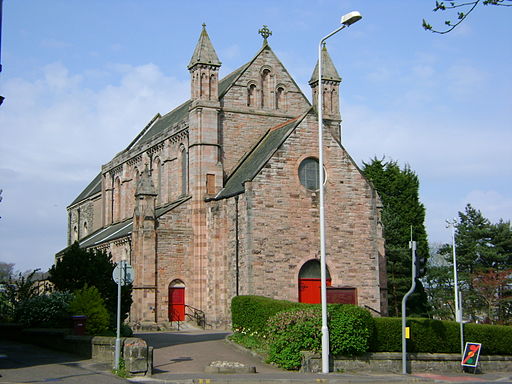Feast Day: November 16
When astronaut Kevin Chilton first launched into orbit, he had a moment of panic. He looked up to see a thin white line cutting across the window that protected him from the deadly vacuum of space. Chilton turned quickly to the commander and said, “I think we have a crack.”
The commander looked over and laughed. He explained, “You’re seeing your first orbital sunrise.”

The curve of white light, perfectly framed by the window, came from the sun slowly peaking around the Earth. It was transcendently beautiful, comparable in Chilton’s mind only to the feeling he had had holding his first child. A minute later, he turned to the other Catholics in the shuttle and asked if they were ready to receive the Eucharist—which he had arranged with his pastor to bring with him into orbit. As they drank in this life-altering experience, they received the Lord.
When I saw the video of Chilton during a parish program, I thought how beautiful it must have been to embrace God while seeing this unique vista of His creation. Yet his first reaction had been panic. He mistook the unexpected intrusion of light into the darkness around him as a threat. Only by listening to the experience of someone else on the journey, and taking a moment’s pause, could Chilton open himself to this incredible gift. How often is that true for us when God breaks into our lives in unexpected ways?
The Exiled Princess
St. Margaret must also have felt panic when she sailed into the North Sea in 1068. She had been born in exile to a member of the English royal family. When St. Edward the Confessor, her childless great-uncle, had reclaimed the English throne from the Danish invaders, he had summoned her family back to England as potential heirs. Margaret was a girl of twelve at the time. A decade later, Edward was dead and England once again had fallen to foreign invaders: the Normans under William the Conqueror. A now grown Margaret took counsel with her brother and mother. Fearing for their lives, they decided once again to flee into exile in mainland Europe.
They failed. A fierce storm whipped up the sea and drove them back onto the coast of Britain, wrecking their ship and scattering their remaining possessions. As they saw men approach, the family had no idea if they were friend or foe. All seemed lost in this disaster. God, however, had something good in store.

The storm had pushed them north from England onto the shores of Scotland. The men served King Malcolm, a tough warrior who had also endured exile in his youth before defeating the usurper Macbeth (of Shakespearean fame) and regaining his father Duncan’s throne. Malcolm was also a widower. When he saw the younger Margaret, he was smitten. Initially, Margaret demurred. After all her troubles, she wanted to withdraw from a harsh world into the sanctuary of a nunnery. Malcolm patiently pressed his suit. Two years later, they married.
Margaret: Saint and Mother of Kings
Historians have suggested various political motives for the royal marriage. Perhaps. What we know for certain is that husband and wife forged a deep and loving partnership. Malcolm respected his wife’s devotion and intelligence, which complemented his own weaknesses as a king who felt most comfortable on the battlefield. Margaret became his chief counselor for domestic affairs where she promoted justice, nurtured religious renewal, and created foundations to assist the poor.
Margaret and Malcolm had eight children together, including three future kings and one queen. She surprised her contemporaries with how much of a mother she was. In a time when royal and noble families often entrusted childrearing to servants, wet nurses, and foster parents, Margaret involved herself daily with her children. She talked to them, prayed with them, and went to church with them. England had been weakened before the Norman invasion by conflict between two brothers—King Harold Godwinson (the final Anglo-Saxon king) and Earl Tostig—and many royal families had similar feuds. In contrast, Margaret’s children learned to love one another and work together. Their surviving letters testify to the holy sense of family she built in them.
Margaret reigned as the people’s beloved queen for over twenty years before falling ill in 1093. Then came a messenger with devastating news. Her dear husband and her eldest son had died in battle fighting the English. Within days, the sick queen followed them into eternal rest. She and Malcolm were buried next to each other.
In 1250, her story acquired a fitting coda. The people had continued to honor their “Pearl of Scotland” and ask for her prayers. When the pope officially declared her a saint, the kingdom came together to solemnly transfer her bones from her tomb to Dunfermline Abbey. They couldn’t budge her coffin. After their efforts failed, the abbot suggested that they move her husband at the same time. Suddenly both coffins could be lifted easily and St. Margaret came to rest in a place of honor in the church alongside the spouse whom she had loved.

Holiness in Hidden Treasures
Margaret’s life offers a lovely example of how God delights in surprising us with hidden joys. Her marriage to Malcolm was not in her plans. She wanted a different life. Fortunately, God foiled her. She found tremendous happiness in her husband and children, and she found with that the opportunity to spread that joy to others. The first lesson I would suggest we can learn from Margaret (and Kevin Chilton) is that events that fill us with fear and frustration may in fact be God breaking into our lives with something far better than we could ever have expected.
The second lesson about which St. Margaret reminds me is simply this: family is holy. Much of the honor paid to her comes from her role as a model mother and wife. It is a holiness accessible to ordinary people.
The blessing of working hard to build a holy family should not be one of God’s hidden surprises, but so many important people in history have missed it. So many kings and queens focused on their office’s power and responsibilities without putting an equal effort into their marriage and children. I suspect this is not just a medieval problem nor are rulers the only people who put their jobs or social position before their family. As saints like Margaret remind us, there is more Christian joy and importance in the vocation of spouse and parent than there is even in being president.
St. Margaret of Scotland, pray for us that we may always trust in God even when things seem to fall apart. Pray for us that we may love our spouses, children, parents, and family as Christ has loved us.
If you have a response, thoughts, or questions, please comment at the bottom of the page. Consider subscribing below to get email notifications about new reflections and other news.



1 Response
[…] my two previous posts, on Edward the Confessor and Margaret of Scotland, this is the story of troubled English royalty. Hilda lived in the 600s, four centuries before […]